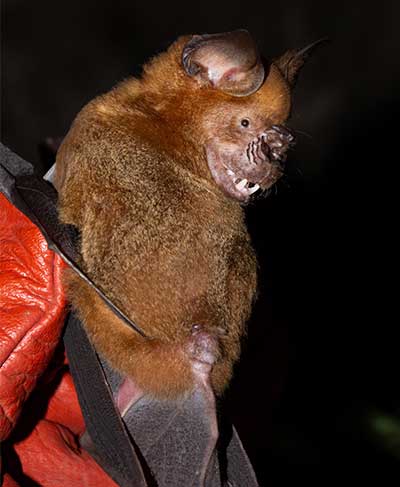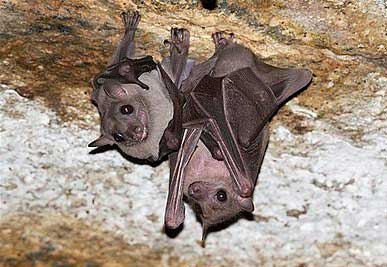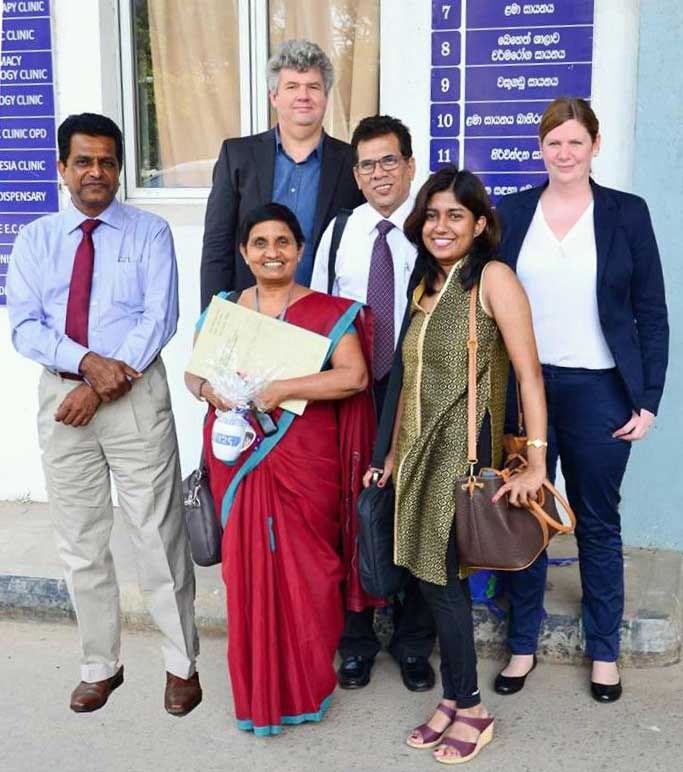
Sri Lankan Bats and Bat-Coronaviruses
ENGLISH සිංහල தமிழ்

New Scientific Finding by the Scientists of the University of Colombo; Sri Lankan Bats and Bat-Coronaviruses
“Corona” has been a word that tormented a whole world for more than a year since the end of 2019. What is this Corona? It created a global level pandemic by infecting more than 180 million people across 220 countries and caused the death of more than 3.9 million patients.
 How this corona came into being? How did it cause such damage within a short period? These have been frequently asked questions in the recent past. SARS-CoV-2 belongs to a large family of viruses called ‘Corona Viruses’. This group consists of four different genera named Alpha, Beta, Gamma, and Delta. Various types of coronaviruses which infect humans, as well as other animals, belong to these four types. So far, seven human coronaviruses have been identified including SARS-CoV which spread in China during the year 2003, MERS-CoV that spread in the Middle East during 2012, and SARS-CoV-2 which caused the recent global pandemic.
How this corona came into being? How did it cause such damage within a short period? These have been frequently asked questions in the recent past. SARS-CoV-2 belongs to a large family of viruses called ‘Corona Viruses’. This group consists of four different genera named Alpha, Beta, Gamma, and Delta. Various types of coronaviruses which infect humans, as well as other animals, belong to these four types. So far, seven human coronaviruses have been identified including SARS-CoV which spread in China during the year 2003, MERS-CoV that spread in the Middle East during 2012, and SARS-CoV-2 which caused the recent global pandemic.
Coronaviruses are important pathogens for humans and vertebrates. They can infect the respiratory, gastrointestinal, hepatic, and central nervous systems of humans, livestock, birds, bats, mice, and many other wild animals. Among the animals, bats have been reported to be a reservoir host for some coronaviruses, SARS and MERS being the best examples. When these viruses start animal‐to‐human and human‐to‐human transmission it marks a zoonotic event. Zoonotic spillover event is when a reservoir population such as bats, with a high pathogen prevalence, comes into contact with a novel host population such as humans.
However, for the transmission from animal to human to happen, important evolutionary changes should take place within the virus in form of mutations. The pathogen transmitted from the reservoir population may or may not be transmitted within the host population. Otherwise, even though the possibility remains, within the animal reservoir, the virus is quite harmless for humans. So, what is this ruckus about the new scientific finding done by the group of scientists of the Faculty of Science of the University of Colombo, in collaboration with the Robert Koch Institute, Germany? With the emergence of SARS-CoV-2 in 2019 interest in the prevalence of coronaviruses in bats was piqued. However, this study was being undertaken since the year 2017, even before corona brought about this pandemic.
Bats (Chiroptera) are an order of mammals with the 2nd highest variety of species worldwide. In Sri Lanka, the suborders of Yinpterochiroptera and Yangochiroptera are both represented in high numbers, accounting for almost 1/3 of the Sri Lankan mammals with 31 different species. Their species variety and other unique features, specifically their ability to fly long distances, their migratory behavior, and gregarious roosting habits, make them important virus reservoirs naturally. Thus the study of these unique animal hosts is an important field of virology to learn more about the co-evolution of bats and viruses and the potential zoonotic transmission of viruses from bats to humans.
Moreover, advanced knowledge on viral transmission mechanisms and virus-host interactions could facilitate the development of antiviral drugs and vaccines as well as preparation against potential pandemics in the future. When considering the high diversity among these animals, the research team successfully assumed that Sri Lankan bat populations might be habouring medically important pathogens including Coronaviruses. Accordingly, the research was conducted based on the said assumption. Investigations were carried on different bat species living in a sympatric colony in the Wavul Galge cave, Koslanda, Sri Lanka.
In three field sessions carried out in 2018 and 2019, the research team captured 395 bats that belonged to Miniopterus, Rousettus, Hipposideros, and Rhinolophus genera. Samples have been collected in form of either rectal swabs or fecal samples and were subjected to screening for coronaviruses using nested PCR method and other different molecular techniques. By the end of the study, the research team has been able to detect α and β CoVs in M. fuliginosus and R. leschenaultii bats respectively, for the first time in Sri Lanka.
Results of this research indicate that the detected CoVs are host-specific for the respective bat species and, despite the sympatric cohabitation in the Wavul Galge cave, an inter-species transmission has not been observed. This supports the assumption that only particular bat species serve as a natural reservoir for harmful human-pathogenic viruses like SARS-CoV, while spill-over events may occur because of environmental impact and the intrusion of humans into the living areas of the bat species. According to this particular research, studying bats and monitoring their viruses as well as the respectful interaction with their natural habitats are both important factors to better understand and prevent zoonotic transmission from bats to humans.
The research was carried out mainly for the Ph.D. studies of Ms. Therese Muzeniek from the Robert Koch Institute, Centre for Biological Threats and Special Pathogens, Highly Pathogenic Viruses Division (ZBS1), Berlin, Germany and Ms. Thejanee Perera from the Institute of Biochemistry, Molecular Biology and Biotechnology, University of Colombo, Sri Lanka within the IDEA project under Global Health Protection Programme. Prof. Wipula B. Yapa, Emeritus Prof. Sunil Premawansa, Prof. Inoka C. Perera, and Mr. Sahan Siriwardana from Identification of Emerging Agents (IDEA) Laboratory, Department of Zoology and Environment Sciences, the Faculty of Science, University of Colombo along with Dr. Gayani Premawansa from North Colombo Teaching Hospital, provided their contribution in making this research a success.
As the faculty of Science, University of Colombo, we congratulate the research team for their important findings and we are humbly proud that such a talented team is a part of the faculty. Because science holds the key to many challenges we face.
කොළඹ විශ්වවිද්යාලයේ විද්යාඥයින්ගේ නවතම සොයා ගැනීම: ශ්රී ලංකාවේ වවුල් විශේෂ සහ වවුල් කොරෝනා වෛරස් ප්රභේද
2019 වර්ෂයේ අග භාගයේ දී ලොව පුරා ව්යාප්තිය ඇරඹූ කොරෝනා වෛරසය අද වන විට ගෝලීය වසංගතයක් බවට පත්වෙමින් මිලියන 180 කට අධික පුද්ගලයින් සංඛ්යාවක් ආසදනය කරමින්, මිලියන 3.9 කට අධික රෝගීන් සංඛ්යාවක් මරණයට පත් කරමින් ලොව පුරා රටවල් 220 ව්යාප්ත වී ඇති බව නොරහසකි.
 මෙම කොරෝනා වෛරසයේ මූලාරම්භය සහ මෙතරම් කෙටි කාලයක් තුල දී මෙම වෛරසය සිදු කල හානිය පිළිබඳව විවිධාකාරයේ මතවාදයන් වර්තමානයේ වඩාත් කතා බහට ලක් වෙමින් පවතී. සැබැවින්ම මෙම SARS-CoV-2 වෛරසයේ මූලාරම්භය කෙසේ සිදු වීද? මෙය අප සැම විසින්ම විමසා බැලිය යුතු කරුණකි. සමස්තයක් වශයෙන් සැලකූ විට, SARS-CoV-2 වෛරසය, “කොරෝනා වෛරස” නම් විශාල වෛරස් පවුලට අයත් වේ. මෙම වෛරස පවුල ඇල්ෆා, බීටා, ගැමා සහ ඩෙල්ටා යන උප කාණ්ඩ හතරකින් සමන්විත වේ. මිනිසුන්ට වැළඳීමේ ප්රවණතාවය සහිත වෛරස කාණ්ඩ ලෙස ඇල්ෆා සහ බීටා කාණ්ඩ දැක්විය හැකිය අතර මෙම කාණ්ඩ දෙකට අදාලව මිනිසුන්ට ආසාදනය විය හැකි කොරෝනා වෛරස් ප්රභේද හතක් මේ වන විට සොයා ගෙන ඇත. 2003 වර්ෂයේ දී චීනයේ ව්යාප්ත වූ SARS-CoV වෛරසයත්, 2012 වර්ෂයේ දී මැද පෙරදිග ව්යාප්ත වූ MERS-CoV වෛරසයත්, වර්තමානයේ ව්යාප්ත වන්නා වූ SARS-CoV-2 වෛරසයත් ඇතුළුව මිනිසුන් සහ විවිධ සතුන් ආසදනය කරනු ලබන නොයෙක් කොරෝනා වෛරස් ප්රභේද මේ වන විට හඳුනා ගෙන ඇත. මිනිසුන් ඇතුළු පෘෂ්ඨවංශී සතුන් හට රෝග ඇති කිරීමේ රෝග කාරකයක් ලෙස මෙම කොරෝනා වෛරස පවුල සුවිශේෂී ස්ථානයක් අත් කරගනී. මිනිසුන්ගේ පමණක් නොව පක්ෂීන්, වවුලන්, මීයන් සහ බොහොමයක් සතුන්ගේ ශ්වසන මාර්ගය, ආහාර මාර්ගය, අක්මාව ආශ්රිත ප්රදේශ සහ මධ්යම ස්නයු පද්ධතිය අසාදනය කිරීමට මෙම වෛරස ප්රභේදයන්ට හැකියාවක් පවතී. ඉහත සඳහන් කල සතුන් අතරින් වවුලන්, SARS සහ MERS වෛරසයන්හි ප්රධාන ධාරකයෙක් ලෙස සඳහන් කල හැක.
මෙම කොරෝනා වෛරසයේ මූලාරම්භය සහ මෙතරම් කෙටි කාලයක් තුල දී මෙම වෛරසය සිදු කල හානිය පිළිබඳව විවිධාකාරයේ මතවාදයන් වර්තමානයේ වඩාත් කතා බහට ලක් වෙමින් පවතී. සැබැවින්ම මෙම SARS-CoV-2 වෛරසයේ මූලාරම්භය කෙසේ සිදු වීද? මෙය අප සැම විසින්ම විමසා බැලිය යුතු කරුණකි. සමස්තයක් වශයෙන් සැලකූ විට, SARS-CoV-2 වෛරසය, “කොරෝනා වෛරස” නම් විශාල වෛරස් පවුලට අයත් වේ. මෙම වෛරස පවුල ඇල්ෆා, බීටා, ගැමා සහ ඩෙල්ටා යන උප කාණ්ඩ හතරකින් සමන්විත වේ. මිනිසුන්ට වැළඳීමේ ප්රවණතාවය සහිත වෛරස කාණ්ඩ ලෙස ඇල්ෆා සහ බීටා කාණ්ඩ දැක්විය හැකිය අතර මෙම කාණ්ඩ දෙකට අදාලව මිනිසුන්ට ආසාදනය විය හැකි කොරෝනා වෛරස් ප්රභේද හතක් මේ වන විට සොයා ගෙන ඇත. 2003 වර්ෂයේ දී චීනයේ ව්යාප්ත වූ SARS-CoV වෛරසයත්, 2012 වර්ෂයේ දී මැද පෙරදිග ව්යාප්ත වූ MERS-CoV වෛරසයත්, වර්තමානයේ ව්යාප්ත වන්නා වූ SARS-CoV-2 වෛරසයත් ඇතුළුව මිනිසුන් සහ විවිධ සතුන් ආසදනය කරනු ලබන නොයෙක් කොරෝනා වෛරස් ප්රභේද මේ වන විට හඳුනා ගෙන ඇත. මිනිසුන් ඇතුළු පෘෂ්ඨවංශී සතුන් හට රෝග ඇති කිරීමේ රෝග කාරකයක් ලෙස මෙම කොරෝනා වෛරස පවුල සුවිශේෂී ස්ථානයක් අත් කරගනී. මිනිසුන්ගේ පමණක් නොව පක්ෂීන්, වවුලන්, මීයන් සහ බොහොමයක් සතුන්ගේ ශ්වසන මාර්ගය, ආහාර මාර්ගය, අක්මාව ආශ්රිත ප්රදේශ සහ මධ්යම ස්නයු පද්ධතිය අසාදනය කිරීමට මෙම වෛරස ප්රභේදයන්ට හැකියාවක් පවතී. ඉහත සඳහන් කල සතුන් අතරින් වවුලන්, SARS සහ MERS වෛරසයන්හි ප්රධාන ධාරකයෙක් ලෙස සඳහන් කල හැක.
මෙම වෛරසයන්ට, සතුන්ගෙන් මිනිසුන්ට සහ මිනිසුන්ගෙන් මිනිසුන්ට ප්රචාරණය වීමේ හැකියාව ලබා ගත හැකි අතර, එය zoonotic spillover ලෙස හැඳින්වේ. විශාල රෝග කාරකයින් ගහණයක් රැගත් සත්ත්ව ගහණයක් (උදාහරණයක් ලෙස වවුල් ගහණයක්) නව ධාරකයන් (උදාහරණයක් ලෙස මිනිසුන්) සමඟ ගැටීමේදී ඇතිවන්නා වූ තත්වය Zoonotic spillover event ලෙස හඳුන්වයි. නමුත්, මෙම රෝග කාරක සත්ව විශේෂය සමඟ ගැටීමෙන් පමණක්ම මෙම රෝගය ව්යාප්ත වන බවට පැවසිය නොහැක.
කෙසේවෙතත්, සතුන්ගෙන් මිනිසුන්ට වෛරස රෝගයක් ප්රචාරණය වීමේදී එම ප්රචාරණය වන වෛරසය තුල විකෘතියක් වැනි වූ සුවිශේෂී පරිණාමික වෙනස් වීමක් සිදුවිය යුතුය. එම ගැටීමෙන් මෙම නව ධාරක විශේෂය තුල මෙම රෝගය පැතිරීම සම්භාවිතවක් මෙන්ම නොපැතිරීමේ සම්භාවිතවයක්ද පවතී. එසේ නොවේ නම්, එම වෛරස ප්රභේදය සත්ව විශේෂ තුළ ව්යාප්තව පැවතියද මිනිසුන් රෝගී කිරීමේ අවදානම පහළ මට්ටමක පවතී. 2019 වර්ෂයේ ආරම්භ වූ SARS-CoV-2 වෛරස ව්යාප්තියත් සමඟ කොරෝනා වෛරසය සහ වවුලන් අතර ඇති සබඳතාව පිළිබඳ වඩාත් කතා බහට ලක් විය. කෙසේ වෙතත් 2019 වර්ෂයේ මෙම වෛරසය ව්යාප්තිය ආරම්භයටත් පෙර සිටම, 2017 වර්ෂයේ දී කොළඹ විශ්ව විද්යාලයේ, විද්යා පීඨය, ජර්මනියේ Robert Koch Institute ආයතනය සමඟ සම්බන්ධ වෙමින් ඇරඹූ පරීක්ෂණ ගණනාවකින් මෙම සබඳතා පිළිබඳ ශ්රී ලංකාවට අදාලව නවතම තොරතුරු රාශියක් අනාවරණය කර ගෙන ඇත.
වවුලන් (Chiroptera) යනු විශාල වූ විශේෂ විවිධත්වයක් ඇති ක්ෂීරපායී සත්ත්ව කොට්ඨාශයකි. ශ්රී ලංකාවේ ජීවත් වන වවුල් ගහන අතරින් Yinpterochiroptera සහ Yangochiroptera යන උප ගහනයනට අදාල විශාල සමාජිකයින් පිරිසක් ශ්රී ලංකාවේ වාසය කරන අතර එය ශ්රී ලංකාවේ ක්ෂීරපායින් අතරින් 1\3 පමණ ප්රමාණයක් ආවරණය කරයි. මෙම වවුලන්ගේ විශේෂ විවිධත්වය, දිගු දුර පියඹායාමට ඇති හැකියාව, සංක්රමණ ආකාරය සහ වාසස්ථාන ඇතුලු වූ ඔවුනටම සුවිශේෂී වූ ලක්ෂණ ස්වභාවිකවම ඔවුන් වෛරස ධාරකයන් බවට පත් කර ඇත. මෙකී හේතු කාරණා නිසා වෛරස සහ වවුලන් අතර වූ සහ-පරිණාමය සහ වවුලන්ගෙන් මිනිසුන්ට වන රෝග සම්ප්රේෂණය පිළිබඳ අධ්යනය වෛරසවිද්යාවේ වැදගත් අංශයක් බවට පත් වී ඇත.
තවදුරටත්, මෙම වෛරස සම්ප්රේෂණ යාන්ත්රන සහ වෛරස-ධාරක සම්බන්ධතාවය පිළිබඳ වූ දැනුම ප්රතිවෛරස ඖෂධ සහ එන්නත් නිපදවීම මෙන්ම අනාගත වසංගත තත්ත්ව වලට මුහුණදීම සඳහා ද මනා පිටිවහලක් වේ. වවුලන් අතර වූ විශාල විශේෂ විවිධත්වය පිළිබඳව සලකා බැලීමේදී වවුල්-කොරෝනා වෛරස් ප්රභේද ශ්රී ලංකාවේ වවුල් විශේෂ අතරත් පැවතිය හැකි බවට අප පර්යේෂණ කණ්ඩායම විසින් සාර්ථකව අනුමාන කරනු ලැබුවා. එයට හේතු කරණා වන්නෙ වවුලන් මෙම වෛරස කාණ්ඩයේ ප්රධාන ධාරක විශේෂයක් ලෙස දැක්විය හැකිවීමයි. ඒ අනුව ශ්රී ලංකාවේ කොස්ලන්ද ප්රදේශයේ වවුල් ගල්ගේ ගුහාව ආශ්රිතව මෙම පරීෂණ කටයුතු මෙහෙයවා ඇති අතර 2018 සහ 2019 වර්ෂයන් තුළ අල්ලා ගන්නා ලද Miniopterus, Rousettus, Hipposideros, සහ Rhinolophus විශේෂ වලට අයත් වවුලන් 395 දෙනෙකු යොදා ගනිමින් නොයෙකුත් පරීක්ෂණ මෙම පර්යේෂණ කණ්ඩායම විසින් සිදු කරනු ලැබ තිබෙනවා. ලබා ගන්නා ලද සාම්පල nested PCR සහ විවිධ අණුක තාක්ෂණ ක්රමවේද භාවිත කරමින් වවුල්-කොරෝනා වෛරස් ප්රභේද අඳුනා ගැනීමට උත්සාහ කර තිබෙනවා. මෙම පරීක්ෂණය අවසානයේ දී ශ්රී ලංකාවේ ප්රථම වතාවට ඇල්ෆා සහ බීටා කාණ්ඩයන්ට අයත් වවුල්-කොරෝනා ප්රභේද M. fuliginosus සහ R. leschenaultii යන වවුල් විශේෂයන් ගෙන් සොයා ගැනීමට පර්යේෂණ කණ්ඩායම සමත් වී තිබෙනවා. පර්යේෂණ ප්රතිඵල අනාවරණය කරන පරිදි මෙම හඳුනාගත් වවුල්-කොරෝනා වෛරස් ප්රභේද මෙම වවුල් විශේෂය සඳහා ධාරක විශිෂ්ඨ වන අතර අන්තර් විශේෂ සම්ප්රේෂණ තහවුරු කර නොමැත.
මෙම ප්රතිඵල මඟින් සනාථ කරන පරිදි ඉහත සඳහන් වවුල් විශේෂ පමණක් මිනිසුන්ට හානිදායක වූ SARS-CoV වෛරස් ප්රභේද සඳහා ස්වභාවික රෝගකාරකයක් විය හැකි බවත් එසේ විය හැක්කේ පාරිසරික බලපෑමක් සහ මිනිසුන් මෙම වවුලන්ගේ වාසස්ථාන වලට බලෙන් ඇතුලු වීමෙන් ඇති කරන තත්ත්වයෙන් බවත් පර්යේෂණ කණ්ඩායම විසින් වැඩිදුරටත් අවධාරණය කරනවා.
මෙම පරීක්ෂණය අනුව වවුලන් පිළිබඳ අධ්යනය, ඔවුනට වැළදෙන වෛරස පිළිබඳ අධ්යනය සහ ඔවුන්ගේ වාසස්ථාන පිළිබඳ අධ්යනය අනාගතයේ දී වැළදිය හැකි රෝග තත්ත්වයන් වලක්වා ගැනීමට මනා පිටිවහලක් වන බව නොඅනුමානය. මෙම පරීක්ෂණය මෙහෙයවන ලද්දේ ජර්මනියේ රොබට් කොච් ආයතනයේ පශ්චාත් උපාධි අපේක්ෂිකා තෙරේසේ මුසනික්, කොළඹ විශ්ව විද්යාලයේ, ජෛවරසායන, අණුක ජීව විද්යා සහ ජෛවතාක්ෂණ ආයතනයේ පශ්චාත් උපාධි අපේක්ෂිකා තේජානි පෙරේරා, කොළඹ විශ්ව විද්යාලයේ විද්යා පීඨයේ සත්ත්ව විද්යා සහ පාරිසරික විද්යා දෙපාර්තමේන්තුව සහ ජර්මනියේ රොබට් කොච් ආයතනයේ සම්බන්දතාවයෙන් ක්රියාත්මක වන Identification of Emerging Agents (IDEA) විද්යාගාරයේ, මහාචාර්ය සුනිල් ප්රේමවංස, මහාචාර්ය විපුල යාපා, මහාචාර්ය ඉනෝක පෙරේරා සහ සහන් සිරිවර්ධන මහතා සමග උතුරු කොළඹ ශික්ෂණ රෝහලේ වෛද්ය ගයනි ප්රේමවංස යන මහත්ම මහත්මීන් ඇතුලු පිරිසකගෙන් සැදුම්ලත් පර්යේෂණ කණ්ඩායමක් විසිනි. මෙවන් වූ සුවිශේෂී පරීක්ෂණයක නියලෙමින් සාර්ථක ප්රතිඵල ලබා ගත් මෙම පරීක්ෂණ කණ්ඩායමට කොළඹ විශ්ව විද්යාලයේ විද්යා පීඨයේ අප සැමගේ හදපිරි ප්රණාමය පුද කර සිටින අතර වර්තමානයේ මෙන්ම අනාගත්යේදීද අප මුහුනපානා විවිධාකාර වූ ගැටලු විසඳීම සඳහා විද්යාත්මක පර්යේෂණ මනා පිටිවහලක් වන බව මෙම පර්යේෂණයද කදිම උදාහරණයක් බවට නිහතමානී ආඩම්බරයකින් යුතුව මතක් කරන්නෙමු.
கொழும்புப்பல்கலைக்கழக விஞ்ஞானிகளின் நவீன விஞ்ஞான கண்டுபிடிப்பு: இலங்கை வெளவால்கள் மற்றும் வெளவால்-கொரோனா வைரஸ் இனங்கள்
கொரோனா எனும் வார்த்தை, 2019 ஆம் ஆண்டிறுதி தொடக்கம் ஒரு வருடத்திற்கும் மேற்பட்ட காலமாக உலகையே உலுக்கிப்போட்டுக்கொண்டிருக்கின்றது. கொரோனா என்பது என்ன? இது உலகளாவிய ரீதியில், 220 நாடுகளில் 180 மில்லியன் மக்களிற்கு தொற்றை ஏற்படுத்தி, 3.9 மில்லியன் மக்களின் உயிரை காவு வாங்கி, பெருந்தொற்று நிலைமையை ஏற்படுத்தியுள்ளமை அனைவரும் அறிந்ததே.
 இது எவ்வாறு உருக்கொண்டது? எவ்வாறு இவ்வளவு குறுகிய காலப்பகுதியில் இவ்வளவிலான பாரிய பாதிப்பை ஏற்படுத்தியது? இந்நாட்களில் பரவலாக கேட்கப்படும் கேள்விகள் இவை.
இது எவ்வாறு உருக்கொண்டது? எவ்வாறு இவ்வளவு குறுகிய காலப்பகுதியில் இவ்வளவிலான பாரிய பாதிப்பை ஏற்படுத்தியது? இந்நாட்களில் பரவலாக கேட்கப்படும் கேள்விகள் இவை.
SARS-CoV-2 என்பது ‘கொரோனா வைரஸ்’ எனப்படும் வைரஸ் குடும்பத்தில் உள்ளடங்கும். இவ்வைரஸ் அல்பா, பீட்டா, காமா, மற்றும் டெல்டா என நான்கு வேறுபட்ட இனங்களைக்கொண்டது. மனிதர்களையும் விலங்குகளையும் தொற்றும் பலவகையான கொரோனா வைரஸ்கள் இவ்வைரஸ்குழுவைச்சாரும். இதுவரை, மனிதர்களைத்தொற்றும் 7 வகையான கொரோனா வைரஸ்கள் கண்டுபிடிக்கப்பட்டுள்ளன. 2003 ஆம் ஆண்டில், சீனாவில் பரவிய SARS-CoV, 2012 ஆம் ஆண்டில் மத்திய கிழக்கு நாடுகளில் பரவிய MERS-CoV மற்றும் இப்பொழுது பரவி வரும் பெருந்தொற்றை ஏற்படுத்திய SARS-CoV-2 வைரஸ் என்பவை இதனுள் அடங்கும்.
கொரோனா வைரஸ் என்பது மனிதர்களையும் மேலும் சில முள்ளந்தண்டுளிகளையும் தொற்றும் முக்கிய நோய்க்கிருமிகளில் ஒன்றாகும். இவை மனிதர்கள், பண்ணை விலங்குகள், பறவைகள், வெளவால்கள், எலிகள் மற்றும் பல காட்டுவிலங்குகள் போன்றவற்றின் சுவாசத்தொகுதி, உணவு சமிபாட்டுத்தொகுதி, ஈரல் மற்றும் மத்திய நரம்புத்தொகுதி என்பவற்றை தொற்றக்கூடியது. விலங்குகளிலேயே, SARS மற்றும் MERS உள்ளடங்கலான கொரோனா வைரஸ்களிற்கான விருந்துவழங்கித்தேக்கமாக வெளவால்களே பதிவு செய்யப்பட்டுள்ளன. இவ்வைரஸ்கள், விலங்கு-மனித மற்றும் மனித-மனித பரவுகையில் ஈடுபடும்பொழுது இறுதியில் அது விலங்குதரு நோய் ஆகின்றது. Zoonotic spillover event என்பது, அதிக நோய்க்கிருமிகளை கொண்ட விருந்துவழங்கித்தேக்கமான வெளவால்கள் போன்ற விலங்குகள், புதிய விருந்துவழங்கிகளான மனிதர்களோடு தொடர்புகொள்ளும்போது ஏற்படும் தொற்று ஆகும்.
எவ்வாறாயினும் விலங்குகளிலிருந்து மனிதருக்கு இப்பரவுகை இடம்பெற வைரஸினுள் முக்கிய பரிணாம மாற்றங்கள் எனும் பிறழ்வுகள் இடம்பெறுதல் அவசியமாகும். நோய்த்தேக்கக்குடித்தொகையில் இருந்து தொற்றிய நோய்க்கிருமிகள் விருந்து வழங்கிகுடித்தொகையில் தொற்றலாம், தொற்றாமல் கூட போகலாம். மேலும் சில சந்தர்ப்பங்களில் பரவுகை இடம்பெற்றாலும் அவை மனித இனத்திற்கு பாதிப்பற்றவையாக இருக்கலாம்.
ஆகவே கொழும்புப்பல்கலைக்கழக விஞ்ஞானபீட விஞ்ஞானிகளின் குழுவொன்றால் ஜேர்மனியின் ரொபர்ட் கோச் நிறுவனத்தோடு இணைந்து கண்டுபிடித்த நவீன விஞ்ஞான கண்டுபிடிப்பின் ஆச்சரியமிகு விடயம் தான் என்ன? 2019 ஆம் ஆண்டில் SARS-CoV-2 இன் பரவலுடன் வெளவால்களில் காணப்படும் இக்கொரோனா வைரஸ்கள் பற்றிய ஆர்வம் அதிகரித்தது. எவ்வாறாயினும் கொரோனா வைரஸ் இப்பெருந்தொற்றை ஏற்படுத்த முன்பே, 2017ஆம் ஆண்டு தொடக்கம் இவ்வாராய்ச்சிகள் மேற்கொள்ளப்பட்டு வருகின்றன.
பாலூட்டிகளான வெளவால்கள் (Chiroptera), உலகளாவிய ரீதியில் 2ஆவது அதிக இனப்பல்வகைமையைக் கொண்ட ஓர் வருணம் ஆகும். இலங்கையில் வாழும் வெளவால் இனங்களில் Yinpterochiroptera மற்றும் Yangochiroptera எனும் இரண்டு உபவருணங்களைச்சேர்ந்த வெளவால்கள் அதிகமாக காணப்படுவதுடன் இலங்கையில் காணப்படும் 31 பாலூட்டி இனங்களின் 1/3 பகுதியை இவை பிரதிநிதித்துவப்படுத்துகின்றன. வெளவால்களின் இனப்பல்வகைமை மற்றும் அவற்றின் சிறப்பம்சங்களான நீண்ட தூரத்திற்கு பறக்கக்கூடியமை, இடம்பெயர்வு நடத்தை, கூடிவாழும் நடத்தை, என்பவை இவை இயற்கையாகவே வைரஸ்களிற்கு விருந்து வழங்கித்தேக்கமாக அமைய காரணமாகின்றன. வெளவால்கள் மற்றும் வைரஸ்களின் இணைப் பரிணாமம் பற்றி கற்று மனிதர்களுக்கு தொற்றும் விலங்குதரு நோய்கள் பற்றி அறிவதற்கு இவ்வகையான தனித்தன்மை வாய்ந்த விருந்துவழங்கிகளைப்பற்றி கற்பது வைரஸ்கள் சம்பந்தமான கற்கையில் முக்கிய இடம் வகிக்கின்றது.
மேலும், வைரஸ் கடத்தப்படும் பொறிமுறைகள் மற்றும் வைரஸ்-விருந்துவழங்கி இடைவினைகள் பற்றிய மேம்படுத்தபட்ட அறிவு, வைரஸ்களிற்கு எதிரான மருந்துகள் மற்றும் தடுப்பூசிகளை கண்டுபிடிப்பதிலும் எதிர்கால பெருந்தொற்றுகளை சமாளிப்பதற்கான ஆயத்தங்களிற்கும் பாரிய உதவியாக அமையும். அதீத இனப்பல்வகைமை காரணமாக வெளவால் இனங்களில் மருத்துவ ரீதியில் முக்கியத்துவம் பெறும் கொரோனா வைரஸ் உட்பட பல நோய்க்கிருமிகள் காணப்படும் எனும் கருதுகோளை விஞ்ஞானிகள் குழு வெற்றிகரமாக முன்வைத்தனர். அதற்கிணங்க மேற்குறிப்பிட்ட கருதுகோளை மையப்படுத்தி ஆராய்ச்சி முன்னெடுக்கப்பட்டது. இவை சம்பந்தமான கற்கைச்செயற்பாடுகள் வெவ்வேறு இனத்தைச்சேர்ந்த வெளவால் இனங்கள் ஒன்றாக ஓரிடக்காலனியாக வாழும் இலங்கை, கொஸ்லாந்தையில் இருக்கும் வவுல் கல்கெ குகையில் மேற்கொள்ளப்பட்டன.
2018 மற்றும் 2019ஆம் ஆண்டுகளில் இடம்பெற்ற 3 களச்செயற்பாடுகளில் Miniopterus, Rousettus, Hipposideros, மற்றும் Rhinolophus இனங்களைச்சேர்ந்த 395 வெளவால்கள் பிடிக்கப்பட்டு மலக்குடல்சார் துடைப்புக்கள் மற்றும் மல மாதிரிகள் இவைகளிடமிருந்து சேகரிக்கப்பட்டன. இம்மாதிரிகளில் கொரோனா வைரஸ்களை இனங்காண்பதற்காக nested PCR முறை மற்றும் வேறு பல மூலக்கூற்று தொழில்நுட்ப முறைகள் முன்னெடுக்கப்பட்டன இவ்வாராய்ச்சியின் முடிவில் இலங்கையில் முதன்முறையாக, α மற்றும் β கொரோனா வைரஸ் வகை வைரஸ்களை முறையே, M. fuliginosus மற்றும் R. leschenaultii எனும் வெளவால் இனங்களில் கண்டுபிடித்தனர்.
இவ்வாராய்ச்சியின் முடிவுகளாவன, கண்டுபிடிக்கப்பட்ட கொரோனா வைரஸ்கள் வெளவால் இனங்களிற்கு தனித்தன்மை வாய்ந்தமையும், இவை வவுல் கல்கெ குகையில் ஓரிடவாழிகள் ஆயினும் இனங்களிற்கிடையேயான பரவுகை காணப்படவில்லை என்பவையே ஆகும். சில வெளவால் இனங்கள் மாத்திரமே SARS-CoV போன்ற மனிதர்களிற்கு தீங்கு விளைவிக்கும் தொற்றை ஏற்படுத்தும் கொரோனா வைரஸ்களிற்கான தேக்கமாக செயற்படுகின்றன எனும் கருதுகோள் இதன் மூலம், உறுதிப்படுத்தப்படுகிறது. அத்துடன், சூழற்காரணிகள் மற்றும் வெளவால்களின் வாழிடத்தினுள் மனித ஊடுருவல் என்பவற்றினாலேயே இவ்வகை கொரோனா வைரஸ்கள் மனிதருக்கு பரவுகின்றன எனும் கருத்து முன்வைக்கப்படுகின்றது. குறிப்பிட்ட ஆராய்ச்சியின்படி வெளவால் இனங்கள் மற்றும் அவற்றின் வைரஸ்களைப்பற்றிய கற்கைகள், அத்துடன் அவை அவற்றின் இயற்கைச்சூழலுடன் ஏற்படுத்திக்கொள்ளும் இடைவினைகள் பற்றிய கற்கைகள் ஆகிய இரண்டும் எதிர்காலத்தில் விலங்குதரு நோய் பரவலை தடுப்பதற்கு மிக முக்கியமான காரணிகளாகும்.
ஜேர்மனியின் ரொபர்ட் கோச் நிறுவனத்தின் உயிரியல் அச்சுறுத்தல்கள் மற்றும் விசேட நோய்க்கிருமிகளிற்கான நிலையத்தின், அதீத நோய்கிருமிகளிற்கான பிரிவைச்சேர்ந்த செல்வி தேரேஸ் முஸினிக் மற்றும் கொழும்புப்பல்கலைக்கழக உயிர் இரசாயனவியல், மூலக்கூற்று உயிரியல், மற்றும் உயிர் தொழில்நுட்பவியலிற்கான நிறுவனத்தைச்சேர்ந்த செல்வி தேஜானீ பெரேரா ஆகியோரின் PhD கற்கைக்காக மேற்கொள்ளப்பட்ட இவ்வாராய்ச்சி உலக சுகாதார பாதுகாப்பு நெறிமுறையின் Identification of Emerging Agents (IDEA) செயற்திட்டத்தின் கீழ் மேற்கொள்ளப்பட்டது. கொழும்புப்பல்கலைக்கழக விஞ்ஞானபீட விலங்கியல் மற்றும் சூழலியல் திணைக்களத்தின் IDEA ஆய்வுக்கூடத்தை சேர்ந்த ஓய்வுபெற்ற பேராசிரியர் Prof .விபுல யாப்பா, பேராசிரியர் Prof. சுனில் பிரேமவம்ச, பேராசிரியர் Prof. இனோக்க பெரேரா மற்றும் திரு சஹன் சிறிவர்தன ஆகியோர் மற்றும் வட கொழும்பு போதனா வைத்தியசாலையின் வைத்தியர் Dr கயனி பிரேமவம்ச என்பவர்களினால் இவ்வாராய்ச்சி வெற்றிகரமாக நிறைவேற்றப்பட்டது.
கொழும்புப்பல்கலைக்கழக விஞ்ஞானபீடம் என்ற வகையில் ஆராய்ச்சிக்குழுவிற்கு எமது வாழ்த்துக்களை தெரிவித்துக்கொள்வதோடு, திறமையான இக்குழு எமது பீடத்தை சார்ந்தது என்பதையும் பெருமிதத்துடன் தெரிவித்துக்கொள்கிறோம். ஏனெனில், நாம் நிகழ்காலத்தில் எதிர்கொள்ளும் பல சவால்களிற்கு விஞ்ஞானத்தின் மூலம் விடை காணலாம் என்பதில் எவ்வித ஐயமும் இல்லை.
References: Muzeniek, T., Perera, T., Siriwardana, S., Bas, D., Kaplan, F., Öruc, M., Becker-Ziaja, B., Schwarz, F., Premawansa, G., Premawansa, S., Perera, I., Yapa, W., Nitsche, A., & Kohl, C. (2021). Detection of Alpha- and Betacoronaviruses in Miniopterus fuliginosus and Rousettus leschenaultii, two species of Sri Lankan Bats. Vaccines, 9(6), 650. https://doi.org/10.3390/vaccines9060650
Image Courtesy:
Title image: https://indiabiodiversity.org/biodiv/img/Rousettus%20leschenaulti/988_gall.jpg
Content image: Ms. Thejanee Perera.
Written by: L.B. Sadani Panchasika






